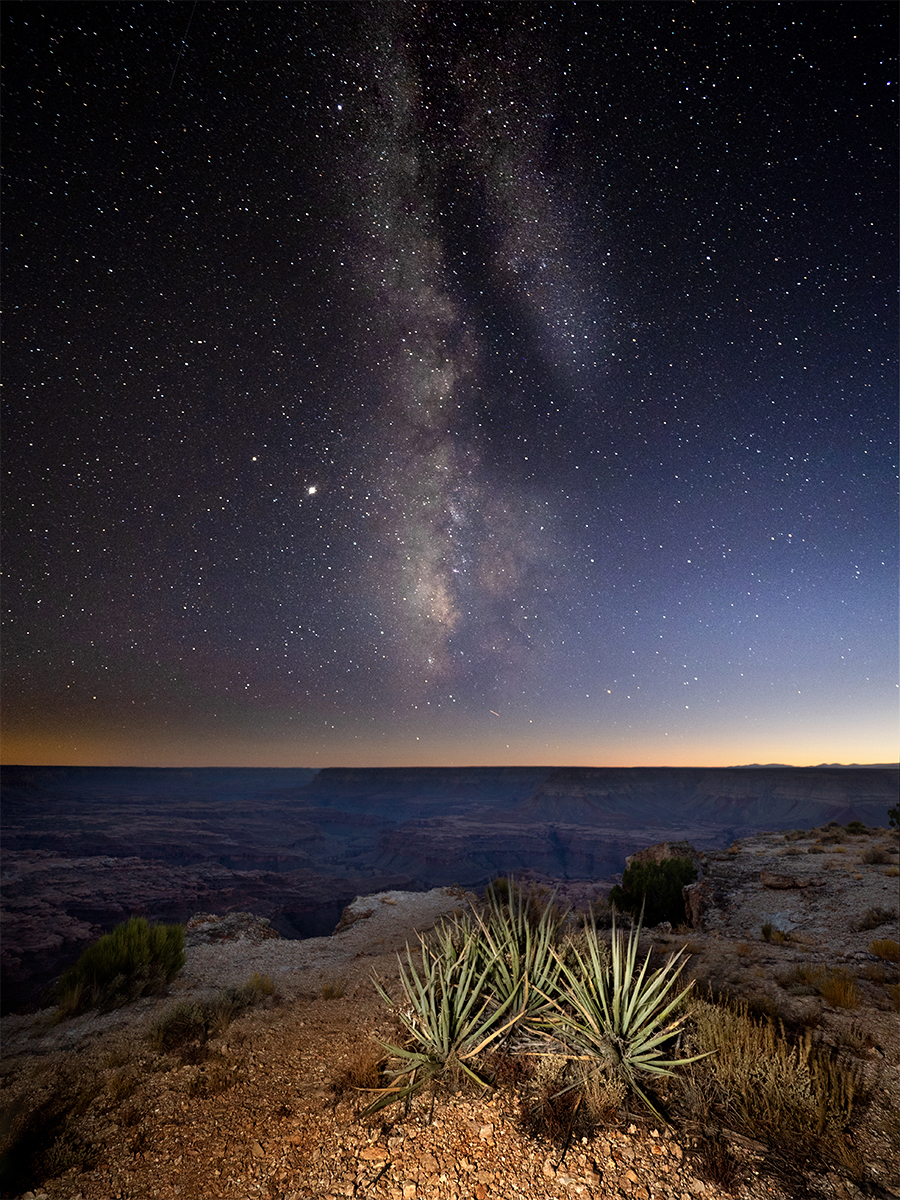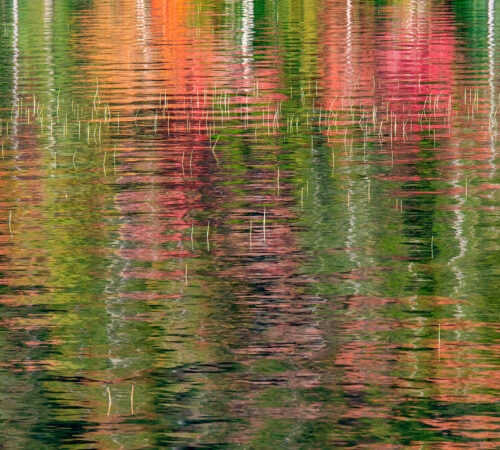Hyperfocal Distances vs. the Infinity Setting

Dear Bubbles,
I’m still working on hyperfocal distance. I’m wondering, when shooting the night sky, instead of focusing on the stars or trying to focus on infinity, would using the hyperfocal distance help me to have some foreground interest in focus as well as sharp stars?
Shirley
Dear Shirley,
Depth of field is so hard! Hyperfocal distance is so confusing! Understanding the depth of field for a scene is challenging enough in broad daylight let alone under the low light levels of night sky. Bravo to you, Shirley, for sticking with it and exploring new ways (i.e., shooting the stars) to expand your photographic toolbox.
When photographing in the dark, our cameras need to expose for longer periods of time to let in more light. To record star trails, our goal is to keep our shutter open for long periods of time, minutes or even hours perhaps. To render frozen stars, though, it’s the opposite. We aim to keep our shutter speeds as short as possible, typically around 15-30 seconds with wide-angle lenses, but even shorter for telephoto lenses. (Yes, 15-30 seconds is considered short for photographing in darkness!)
To achieve these shorter shutter speeds, we let as much light in with the other two exposure settings—ISO and aperture—as possible. We need to adjust our ISOs (ISO 1600 or faster) and use wider apertures (f/4 or wider).
When we photograph with wide apertures, we reduce the depth of field. When we reduce the depth of field, we reduce the apparent range of sharpness in our photograph. This works just fine when our composition only includes stars in galaxies far, far away. But what if we have visual elements in the foreground to help set the scene for our night sky?
Including foreground can increase interest in your astro compositions but can also complicate how we render depth of field in our frame as we balance letting enough light into our lens. Paying attention to the hyperfocal distance measurement can indeed help you determine whether your foreground AND stars will appear in sharp focus.
As a reminder, depth of field is defined as how much of your frame appears in sharp focus. Three things affect the depth of field range for a photograph:
- The focal length of your lens. Wider-angle lenses possess broader depth of field at a given aperture than telephoto and macro lenses.
- How physically close your camera is to a subject. The closer your camera is to a subject, the shorter the depth of field. The farther away your camera is to a subject, the broader the depth of field.
- Your aperture setting. When it comes to aperture settings, a big number (e.g. f/16) renders a bigger depth of field. A small number (e.g. f/2.8), small depth of field.
(If you’d like a longer refresh on depth of field in general, please visit my “Another Dose of Depth of Field” article at https://dearbubbles.com/2020/04/another-dose-of-depth-of-field.)
The hyperfocal distance is a calculated number that renders the maximum range of depth of field for your camera, lens focal length, and aperture. Once calculated, the hyperfocal distance is the distance at which you must focus such that half of that distance to infinity appears to be in sharp focus in your photograph. It’s math. A lotta math. Math is hard…math isn’t what you want to be doing while enjoying a beautiful night under the stars, is it?
Thankfully, depth of field apps exist for mobile devices to help you do the calculation. I use the Depth of Field Calculator for iPhone: https://apps.apple.com/us/app/depth-of-field-calculator/id356339910. There are a bunch of different apps out there (including Photo Pills). They all do the same thing just with different interfaces. Pick one, any one, and learn it inside out.
After you enter your camera model, lens focal length, and aperture setting into your chosen app, the software will spit out a single number for hyperfocal distance. This number is the exact number you must set your focus point to maximize your depth of field. It’s the number you “Have to Focus” on in order for half of that distance to infinity to be in focus. Think H.F.: HyperFocal=Have to Focus
For the 7-14 mm lens I use when shooting the night sky (which is a 14-28mm equivalent in full-frame/35-mm speak), I know from my app that the hyperfocal distance for my 7mm focal length lens on my Olympus OMD EM1 Mark III set to f/2.8 equals 3.96 feet. Let’s round to 4 feet. (When it comes to depth of field, always round up, not down! You’ll see why in a second.)
This hyperfocal distance measure tells me that if I set my focus to 4 feet away from my camera, everything contained in my scene from 2 feet to infinity will be in sharp focus. Anything appearing closer than 2 feet from my camera will not be in focus since it’s outside that range.
So, then I check my composition and ask: “Do I have anything in my frame that appears physically closer to my camera that is less than 2 feet away?”
If I have a rock or a branch or even a little bit of dirt that is 1 foot in front of my camera, it will not be in focus. If I want those visual elements that are 1 foot away from my camera to be in focus, I must adjust something, specifically my aperture to be narrower, my focal length to be wider, and/or increase my physical distance from those visual elements to at least two feet. Because my lens does not go any wider than f/2.8 and I do not have a wider-angle lens, my only choice is to take a step or two backwards until my visual elements fit within that 2-foot to infinity window.
Then I manually set my focus point to 4 feet to match the hyperfocal distance. I do NOT set my focus point to 2 feet. I HAVE TO FOCUS at 4 feet so that everything from 2 feet to infinity stays sharp.
If I focus my camera on any distance closer than 4 feet, I will not be able to achieve focus to infinity and I will significantly reduce the range of depth of field in my image. To use the example we started with, if I focus at 2 feet with my Olympus camera with my 7mm lens set to f/2.8, only 1.33 feet to 4.04 feet will appear in sharp focus. That equates to a 2.71-foot depth of field. Only that 2.71-foot window will be in focus. The rock will look sharp, but the stars won’t. Boo! When it comes to depth of field, go long. If you’re going to err, focus farther out into the distance. Do not focus closer. (And this is why we always round up the hyperfocal distance and not round down. It keeps us from focusing closer and reducing the depth of field.)
How do I know what 4 feet is, and how do I measure this in the dark? I’m so glad you asked! You could use rulers or get lasers to precisely measure. That’s just more stuff to carry. Instead, I eyeball the distance using my outstretched arm (which is about 3 feet long). I then shine a flashlight or a headlamp at that distance out while manually focusing on an object in that range. As I manually turn my focus ring, my focus peaking kicks in to help me fine-tune my setting (yes, even my stars will get outlined with yellow while focus peaking).
When you set your lens to infinity focus, you skip all this math stuff. But this setting is NOT the same as using the hyperfocal distance calculation. Each camera and lens will have a slightly different infinity point. Olympus suggests its cameras focus about 20 feet away when set to infinity focus. Twenty feet is not the hyperfocal distance for my 7mm lens set to f/2.8. It’s 4 feet, remember?
I don’t have an infinity focus function on my Olympus lens. (My Olympus camera, however, has a Starry Night AF (auto-focus) function which is similar to the infinity focus setting on lenses, only automated). For the sake of example, let’s say I did. According to my Depth of Field Calculator app, if I focus at 20 feet instead of 4 feet, my depth of field range will equal 3.31 feet to infinity. (When you enter a number in the Distance field in the apps, you’ll see a near-focus-point value and a far-focus-point value.)
That means my rock at 1 foot is definitely not in focus but now anything closer than 3.31 feet is not either. This has reduced my range of depth of field. But only by a little. That small shift could make the difference between something in focus in the foreground or not. Or it may not matter at all if you don’t have anything in your foreground that’s closer that 3.31 feet.
If I focused at the hyperfocal distance (i.e., 4 feet in this example), everything from 2 feet to infinity will be in focus. Two feet to infinity is a (slightly) greater range than 3.31 feet to infinity. This could make all the difference in the world if you have something within the 2 to 3.31-foot range in your composition.
So the short answer to your question is, “It depends.” Just know that you’ll get greater depth of field ranges (i.e., apparent sharpness across more of your frame) by paying attention to the hyperfocal distance than you will through using the infinity focus settings on your lens (or in camera). Using hyperfocal will give you more flexibility whether you’re focusing on astrophotography, landscape photography, or any type of photography where you include great distances between foreground and background elements.
By the way, if you do use the infinity focus setting on your lens, please do yourself a big favor and test this alignment extensively. When I photographed with Canon cameras and lenses, precisely lining up my lens’ tick mark did not render sharp focus at infinity. My stars were not sharp. After much frustration and experimentation, I found I had to line up my tick mark just slightly past the infinity line (closer to the infinity symbol) to render acceptable sharpness. Every camera and lens will differ—make sure you know the best approach for your own gear.
Then go reach for the stars!
Be well, be brave, be wild,
Bubbles
Have a question about photography and/or the creative life? Need some advice? Looking for inspiration? Send your question to Dear Bubbles at colleen@colleenminiuk.com to be possibly featured in a future column post. (If you’d prefer a different display name than your real first name, please include your preferred nickname in your note.)
If you liked this free post, please consider supporting Dear Bubbles either through a monthly contribution through Patreon or a one-time donation through Buy Me a Coffee. Learn more about both at https://dearbubbles.com/support.
The new “Making the Photo” video series is here! Check out the first episode at https://dearbubbles.com/2025/02/making-the-photo-turning-the-page. Catch the other monthly episodes by becoming a Patreon supporter for just $2/month.



